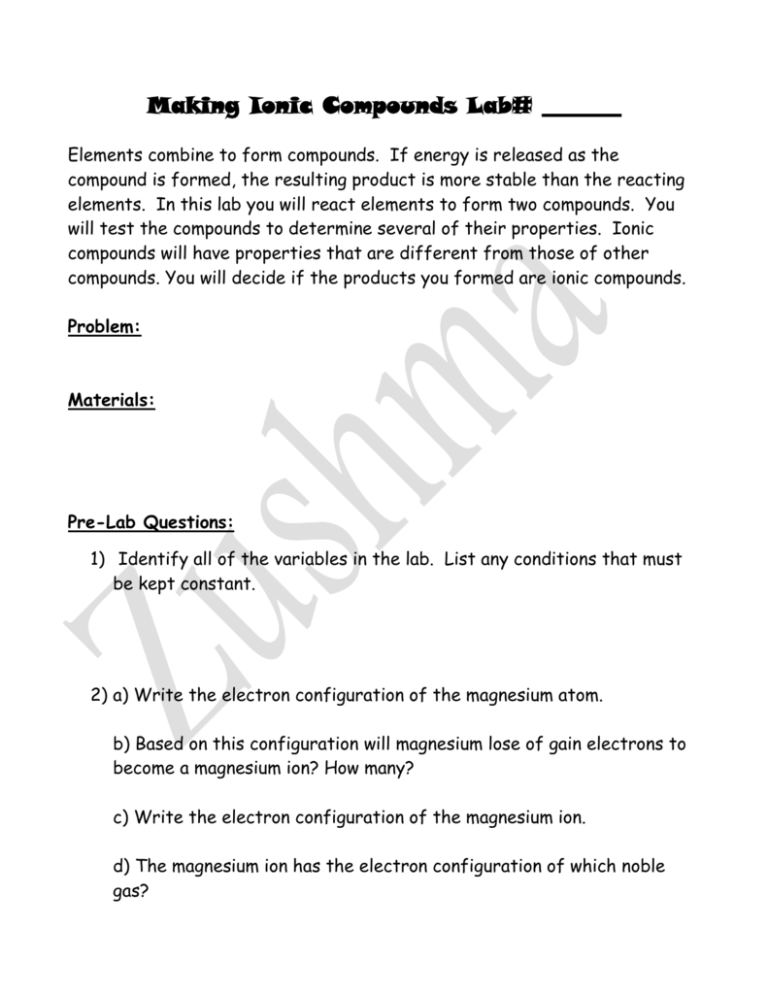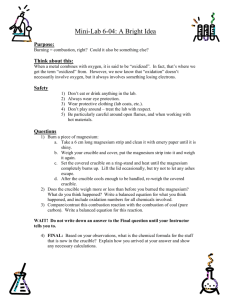Making Ionic Compound Lab
advertisement

Making Ionic Compounds Lab# _______ Elements combine to form compounds. If energy is released as the compound is formed, the resulting product is more stable than the reacting elements. In this lab you will react elements to form two compounds. You will test the compounds to determine several of their properties. Ionic compounds will have properties that are different from those of other compounds. You will decide if the products you formed are ionic compounds. Problem: Materials: Pre-Lab Questions: 1) Identify all of the variables in the lab. List any conditions that must be kept constant. 2) a) Write the electron configuration of the magnesium atom. b) Based on this configuration will magnesium lose of gain electrons to become a magnesium ion? How many? c) Write the electron configuration of the magnesium ion. d) The magnesium ion has the electron configuration of which noble gas? 3) a) Write the electron configuration of the oxygen atom. b) Based on this configuration will oxygen lose of gain electrons to become an oxygen ion? How many? c) Write the electron configuration of the oxygen ion. d) The oxygen ion has the electron configuration of which noble gas? 4) a) Write the electron configuration of the nitrogen atom. b) Based on this configuration will nitrogen lose of gain electrons to become a nitrogen ion? How many? c) Write the electron configuration of the nitrogen ion. d) The nitrogen ion has the electron configuration of which noble gas? In the data table: a. Which mass values will be measured directly? b. Which mass values will be calculated? c. If the mass values must be calculated, what will the equation be to calculate them? Procedure: 1) Arrange the ring on the ring stand so that it is about 7cm above the top of the Bunsen burner. Place the clay triangle on the ring. 2) Measure the mass of the clean, dry crucible and record the mass into the data table. 3) Roll 25cm of magnesium ribbon into a loose ball. Place it in the crucible. Measure the mass of the magnesium and crucible and record the mass in the data table. 4) Place the crucible on the clay ring (as shown below). 5) Light the Bunsen burner away from the crucible. Place the flame under the crucible and heat the crucible. Make sure the crucible is at the top of the flame. 6) When the magnesium metal ignites and begins to burn with a bright white light, immediately turn off the Bunsen burner. Caution: Do Not look directly at the burning magnesium! 7) After the magnesium and crucible have cooled, measure their mass and record it in the data table. 8) Place the magnesium in a small beaker for further testing. 9) Add 10ml of distilled water to the dry magnesium product in the beaker and stir. Check the mixture with a conductivity tester, and record your results. Data Table: Material Mass Empty Crucible Crucible and Mg Ribbon BEFORE heating Magnesium Ribbon Crucible and Mg Product AFTER heating Magnesium Products Observations: Post Lab Questions: 1) What kind of energy was released by this reaction? What can you conclude about the product of this reaction? 2) How do you know that the magnesium metal reacts with certain components in the air? (Hint: Look at your data!) 3) Magnesium reacts with both oxygen and nitrogen from the air at the high temperature in the crucible. Predict the binary formula for both products. Write the names of these two compounds. 4) The product formed from magnesium and oxygen is while and the product formed from magnesium and nitrogen is yellow. From your observations, which compound makes up most of the product? 5) Did the magnesium compounds and water conduct an electric current? Do the results indicate whether or not the compounds are ionic? 6) IF your magnesium had lost mass instead of gaining mass, what do you think a possible source of error would have been? (Pretend yours lost mass to answer the question!)






